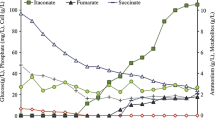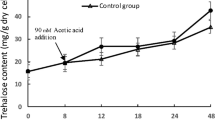Abstract
Natamycin is a polyene macrolide antibiotic and widely used as a natural food preservative. Fungal elicitor had positive effects on the natamycin biosynthesis in Streptomyces natalensis HW-2. However, the global gene expression in response to fungal elicitor is not still reported. In the study, RNA-Seq was used to check the change of transcriptome by fungal elicitor in S. natalensis HW-2. The results showed that there were 1265 differential expression genes (DEGs) at 40 h and 2196 DEGs at 80 h. Most of the genes involved in natamycin biosynthesis were upregulated. KEGG pathway analysis showed that fungal elicitor had strong effects on the transcriptional levels of genes related to branch-chained amino acid (BCAA) metabolism. There were 23 upregulated or downregulated DEGs involved in BCAA biosynthesis and degradation at 40 h and 80 h. To confirm whether the improvement of BCAA biosynthesis could produce more natamycin, metabolic engineering was used to homologously overexpress the gene ilvH which encoded the regulatory subunit of acetolactate synthase (ALS) in S. natalensis. The results showed that overexpression of ilvH in S. natalensis HW-2 increased natamycin production to 1.25 g/L in the flask, which was a 32% increase compared with that of the parent strain. Real-time quantitative PCR analysis showed that the transcriptional level of ilvH in mutant strain S. natalensis ZS101 was significantly increased. Acetyl-CoA content was also raised. The results suggested that the fungal elicitor enhanced natamycin biosynthesis by improving precursor supply via BCAA metabolism. This study will open a new avenue for enhancing natamycin production by metabolic engineering and adding fungal elicitor.
Key Points
• The fungal elicitor had strong effects on the transcriptional levels of genes related to branch-chained amino acid metabolism by RNA-Seq.
• The homologous overexpression of gene ilvH increased natamycin production by 32% and acetyl-CoA content was raised in mutant strain S. natalensis ZS101.






Similar content being viewed by others
References
Abdelmohsen UR, Grkovic T, Balasubramanian S, Kamel MS, Quinn RJ, Hentschel U (2015) Elicitation of secondary metabolism in Actinomycetes. Biotechnol Adv 33:798–811. https://doi.org/10.1016/j.biotechadv.2015.06.003
Aparicio JF, Caffrey P, Gil JA, Zotchev SB (2003) Polyene antibiotic biosynthesis gene clusters. Appl Microbiol Biotechnol 61:179–188. https://doi.org/10.1007/s00253-002-1183-5
Aparicio JF, Mendes MV, Anton N, Recio E, Martin JF (2004) Polyene macrolide antibiotic biosynthesis. Curr Med Chem 11(12):1645–1656. https://doi.org/10.2174/0929867043365044
Aparicio JF, Barreales EG, Payero TD, Vicente CM, Pedro A, Santos-Aberturas J (2016) Biotechnological production and application of the antibiotic pimaricin: biosynthesis and its regulation. Appl Microbiol Biotechnol 100(1):61–78. https://doi.org/10.1007/s00253-015-7077-0
Basilico JC, Debasilico MZ, Chiericath C, Vinderola CG (2001) Characterization and control of thread mould in cheese. Lett Appl Microbiol 32(6):419–423. https://doi.org/10.1046/j.1472-765X.2001.00934.x
Chen GQ, Lu FP, Du LX (2008) Natamycin production by Streptomyces gilvosporeus based on statistical optimization. J Agric Food Chem 56:5057–5061. https://doi.org/10.1021/jf800479u
Dezfulian MH, Foreman C, Jalili E, Pal M, Dhaliwal RK, Roberto DA, Imre KM, Kohalmi SE, Crosby WL (2017) Acetolactate synthase regulatory subunits play divergent and overlapping roles in branched-chain amino acid synthesis and Arabidopsis development. BMC Plant Biol 17:71–83. https://doi.org/10.1186/s12870-017-1022-6
El-Nabarawi MA, Rehem RT, Teaima M (2019) Natamycin niosomes as a promising ocular nanosized delivery system with ketorolac tromethamine for dual effects for treatment of candida rabbit keratitis in vitro/in vivo and histopathological studies. Drug Dev Ind Pharm 4:1–15. https://doi.org/10.1080/03639045.2019.1579827
Elsayed EA, Farid MAF, HA EI-E (2013) Improvement in natamycin production by Streptomyces natalensis with the addition of short-chain carboxylic acids. Process Biochem 48(12):1831–1838. https://doi.org/10.1016/j.procbio.2013.09.009
Elsayed EA, Farid MA, El-Enshasy HA (2019) Enhanced natamycin production by Streptomyces natalensis in shake-flasks and stirred tank bioreactor under batch and fed-batch conditions. BMC Biotechnol 19:46. https://doi.org/10.1186/s12896-019-0546-2
Endo M, Shimizu T, Fujimori T, Yanagisawa S, Toki S (2013) Herbicide-resistant mutations in Acetolactate synthase can reduce feedback inhibition and lead to accumulation of branched-chain amino acids. Food Nut Sci 4:522–528. https://doi.org/10.4236/fns.2013.45067
Hu J, Chu J, Chen J, Zhuang Y, Zhang S, Luo J, Bai H (2004) Effects of amino acid precursor on the avermectin biosynthesis. Chin J Antibiot 29(7):388–390. https://doi.org/10.3969/j.issn.1001-8689.2004.07.002
Ilknur C, Arzu CM (2019) Determination of antifungal effect of edible coatings containing Williopsis saturnus var. saturnus against yeast and mold growth on kashar cheese. J Food Sci 84(2):311–318. https://doi.org/10.1111/1750-3841.14431
Kawai K, Wang G, Okamoto S, Ochi K (2007) The rare earth, scandium, causes antibiotic overproduction in Streptomyces spp. FEMS Microbiol Lett 274:311–315. https://doi.org/10.1111/j.1574-6968.2007.00846.x
Kim M, Yi JS, Kim J, Kim JN, Kim MW, Kim BG (2014) Reconstruction of a high-quality metabolic model enables the identification of gene overexpression targets for enhanced antibiotic production in Streptomyces coelicolor A3(2). Biotechnol J 9(9):1185–1194. https://doi.org/10.1002/biot.201300539
Li Q, Peng Z, Chen X, Sun X, Pan X, Zhao Y (2013) Selection of reference genes for virulence gene expression in Vibrio parahaemolyticus. Acta Microbiol Sinica 53(3):306–312. https://doi.org/10.13343/j.cnki.wsxb.2013.03.012
Li M, Chen S, Li J, Ji Z (2014) Propanol addition improves natamycin biosynthesis of Streptomyces natalensis. Appl Biochem Biotechnol 172:3424–3432. https://doi.org/10.1007/s12010-014-0766-9
Liang J, Xu Z, Liu T, Lin J, Cen P (2008) Effects of cultivation conditions on the production of natamycin with Streptomyces gilvosporeus LK-196. Enzym Microb Technol 42:145–150. https://doi.org/10.1016/j.enzmictec.2007.08.012
Liu G, Chater KF, Chandra G, Niu G, Tan H (2013) Molecular regulation of antibiotic biosynthesis in Streptomyces. Microbiol Mol Biol Rev 77(1):112–143. https://doi.org/10.1128/MMBR.00054-12
Liu SP, Yuan PH, Wang YY, Liu XF, Zhou ZX, Bu QT, Yu P, Jiang H, Li YQ (2015) Generation of the natamycin analogs by gene engineering of natamycin biosynthetic genes in Streptomyces chattanoogensis L10. Microbiol Res 173:25–33. https://doi.org/10.1016/j.micres.2015.01.013
Livak KJ, Schmittgen TD (2001) Analysis of relative gene expression data using real time quantitative PCR and the 2–ΔΔCt method. Methods 12:402–408. https://doi.org/10.1006/meth.2001.1262
Luo JM, Li JS, Liu D, Liu F, Wang YT, Song XR, Wang M (2012) Genome shuffling of Streptomyces gilvosporeus for improving natamycin production. J Agric Food Chem 60:6026–6036. https://doi.org/10.1021/jf300663w
McCourt JA, Duggleby RG (2006) Acetohydroxyacid synthase and its role in the biosynthetic pathway for branched-chain amino acids. Amino Acids 31(2):173–210. https://doi.org/10.1007/s00726-005-0297-3
Murphy TM, Nilsson AY, Roy I, Harrop A, Dixon K, Keshavarz T (2011) Enhanced intracellular Ca2+ concentrations in Escherichia coli and Bacillus subtilis after addition of oligosaccharide elicitors. Biotechnol Lett 33:985–991. https://doi.org/10.1007/s10529-010-0511-6
Nic Lochlainn L, Caffrey P (2009) Phosphomannose isomerase and phosphomannomutase gene disruptions in Streptomyces nodosus: impact on amphotericin biosynthesis and implications for glycosylation engineering. Metab Eng 11:40–47. https://doi.org/10.1016/j.ymben.2008.08.007
Nutzmann HW, Reyes-Dominguez Y, Scherlach K, Schroeckh V, Horn F, Gacek A (2011) Bacteria-induced natural product formation in the fungus Aspergillus nidulans requires Saga/Ada-mediated histone acetylation. Proc Natl Acad Sci USA 108:14282–14287. https://doi.org/10.1073/pnas.1103523108
Ochi K, Hosaka T (2013) New strategies for drug discovery: activation of silent or weakly expressed microbial gene clusters. Appl Microbiol Biotechnol 97:87–98. https://doi.org/10.1007/s00253-012-4551-9
Radman R, Saez T, Bucke C, Keshavarz T (2003) Elicitation of plants and microbial cell systems [J]. Biotechnol Appl Biochem 37(1):91–102. https://doi.org/10.1042/BA20020118
Radman R, Bland EJ, Sangworachat N, Bucke C, Keshavarz T (2006) Effects of oligosaccharides and polysaccharides on the generation of reactive oxygen species in different biological systems. Biotechnol Appl Biochem 44:129–133. https://doi.org/10.1042/BA20050117
Recio E, Aparicio JF, Rumbero A, Martin JF (2006) Glycerol, ethylene glycol and propanediol elicit pimaricin biosynthesis in the PI-factor-defective strain Streptomyces natalensis npi287 and increase polyene production in several wild-type Actinomycetes. Microbiology 152:3147–3156. https://doi.org/10.1099/mic.0.28953-0
Stirrett K, Denoya C, Westpheling J (2009) Branched-chain amino acid catabolism provides precursors for the type II polyketide antibiotic, actinorhodin, via pathways that are nutrient dependent. J Ind Microbiol Biotechnol 36(1):129–137. https://doi.org/10.1007/s10295-008-0480-0
Tanaka Y, Kasahara K, Hirose Y, Murakami K, Kugimiya R, Ochi K (2013) Activation and products of the cryptic secondary metabolite biosynthetic gene clusters by rifampin resistance (rpoB) mutations in Actinomycetes. J Bacteriol 195:2959–2970. https://doi.org/10.1128/JB.00147-13
Trapnell C, Williams BA, Pertea G, Mortazavi A, Kwan G (2010) Transcript assembly and quantification by RNA-Seq reveals unannotated transcripts and isoform switching during cell differentiation. Nat Biotechnol 28:511–515. https://doi.org/10.1038/nbt.1621
van Wezel GP, McDowall KJ (2011) The regulation of the secondary metabolism of Streptomyces: new links and experimental advances. Nat Prod Rep 28(7):1311–1333. https://doi.org/10.1093/femsre/fux005
Vyazmensky M, Zherdev Y, Slutzker A, Belenky I, Kryukov O, Barak Z, Chipman DM (2009) Interactions between large and small subunits of different acetohydroxyacid synthase isozymes of Escherichia coli. Biochemistry 48(36):8731–8737. https://doi.org/10.1021/bi9009488
Wang Y, Wu C, Chu J (2010) Regulation of branched-chain amino acid catabolism: glucose limitation enhances the component of isovalerylspiramycin for the bitespiramycin production. Bioprocess Biosyst Eng 33:257–265. https://doi.org/10.1007/s00449-009-0320-2
Wang DH, Yuan JF, Gu SB, Shi Q (2013) Influence of fungal elicitors on biosynthesis of natamycin by Streptomyces natalensis HW-2. Appl Microbiol Biotechnol 97(12):5527–5534. https://doi.org/10.1007/s00253-013-4786-0
Wang DH, Wei LL, Zhang Y, Zhang MJ, Gu SB (2017) Physicochemical and microbial responses of Streptomyces natalensis HW-2 to fungal elicitor. Appl Microbiol Biotechnol 101:6705–6712. https://doi.org/10.1007/s00253-017-8440-0
Wang DH, Zhang Y, Zheng YY, Chen YX, Xu P, Wang ZX (2019) Effect of L-valine on biosynthesis of natamycin by Streptomyces natalensis HW-2. Fine Chem 36(4):708–714. https://doi.org/10.13550/j.jxhg.20180441
Yi JS, Kim M, Kim EJ, Kim BG (2018) Production of pikromycin using branched chain amino acid catabolism in Streptomyces venezuelae ATCC 15439. J Ind Microbiol Biotechnol 45(5):293–303. https://doi.org/10.1007/s10295-018-2024-6
Yu P, Liu SP, Bu QT, Zhou ZX, Zhu ZH, Huang FL, Li YQ (2014) WblAch, a pivotal activator of natamycin biosynthesis and morphological differentiation in Streptomyces chattanoogensis L10, is positively regulated by AdpAch. Appl Environ Microbiol 80:6879–6887. https://doi.org/10.1128/AEM.01849-14
Zhang SY, Wei LL, Zhang Y, He J, Wang DH (2016) Breeding of high natamycin-producing strains and optimizing of fermentation process. J Henan University Sci Technol 37(4):81–86. https://doi.org/10.15926/j.cnki.issn1672-6871.2016.04.017
Zhu H, Sandiford SK, van Wezel GP (2014) Triggers and cues that activate antibiotic production by Actinomycetes. J Ind Microbiol Biotechnol 41:371–386. https://doi.org/10.1007/s10295-013-1309-z
Funding
The financial support was provided by the National Natural Science Foundation of China (No. 31401672) and Fund of Young Teachers in Colleges and Universities of Henan Province (2016GGJS-060).
Author information
Authors and Affiliations
Contributions
Dahong Wang designed the experiments and analyzed the data. Wenhao Shen, LanLan Wei, and Ying Zhang performed all experiments. Wenhao Shen and Dahong Wang wrote the manuscript. All authors read and approved the final manuscript.
Corresponding author
Ethics declarations
Conflict of interest
The authors declare that they have no conflict of interest.
Ethics approval
Not applicable.
Additional information
Publisher’s note
Springer Nature remains neutral with regard to jurisdictional claims in published maps and institutional affiliations.
Electronic supplementary material
ESM 1
(PDF 396 kb)
Rights and permissions
About this article
Cite this article
Shen, W., Wang, D., Wei, L. et al. Fungal elicitor-induced transcriptional changes of genes related to branched-chain amino acid metabolism in Streptomyces natalensis HW-2. Appl Microbiol Biotechnol 104, 4471–4482 (2020). https://doi.org/10.1007/s00253-020-10564-5
Received:
Revised:
Accepted:
Published:
Issue Date:
DOI: https://doi.org/10.1007/s00253-020-10564-5




